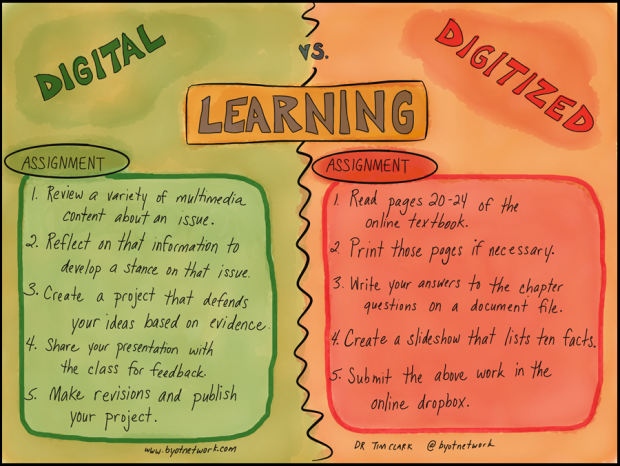 |
| Image from @byotnetwork |
In the graphic above, Dr. Clark lists five different examples of lessons from both a digitized and a digital perspective. Digitized learning uses technology, but, to call upon the theories of Dr. Ruben Puentedura who created the SAMR Model, the use of technology does not transform the learning experience for students, nor does it give students control over how to interact with content or demonstrate learning.
Digitized learning uses technology to complete Substitution- and Augmentation-level lessons in which each student simply regurgitates content through assignments chosen by the teacher. Students do not control the learning experience or the assessment of learning.
Digital learning uses technology to complete Modification- and Redefinition-level lessons in which each student must gain understanding of concepts and creatively demonstrate learning. Students control both the learning experience and the assessment of learning.
 |
| Image from @alicekeeler |
Fundamentally, the difference between digitized learning and digital learning lies in the instructional practices of the teacher. Technology cannot save a lesson that does not provide a meaningful, personalized learning experience. Likewise, poor use of technology can undercut a great lesson.
Is technology going to be additive or transformational?
Dr. Clark offers the following advice for integrating technology:
"Review some of the learning experiences that your are providing for your students that involve technology. Consider what level of the SAMR Model are you addressing with your instructional tasks. One simple way of moving to more truly digital learning experiences, instead of solely digitizing learning, is to provide open-ended assignments that encourage students to make choices. Until they have more practice and experience, students often prefer digitized learning activities because they require less effort, and we have taught them how to succeed by following basic directions. Districts and schools can assist teachers by providing the necessary digital resources, a sustainable digital curriculum, consistent professional learning, and achievable expectations. Likewise, multiple opportunities for on-going feedback, support, and collaboration with a variety of digital tools and content can help your students become effective and creative digital learners."



This comment has been removed by the author.
ReplyDeleteThis comment has been removed by the author.
ReplyDeleteThis comment has been removed by the author.
ReplyDelete